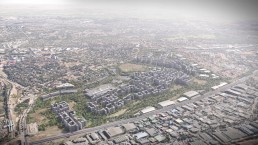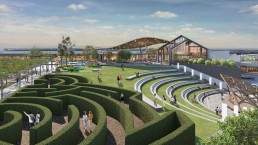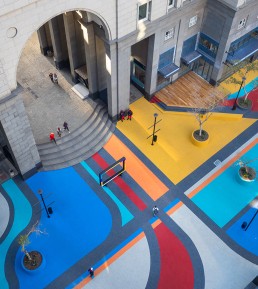Happy International World Architecture Day to celebrate this day we will be looking at some of the projects Boogertman + Partners have developed that exemplify integrated resilient communities.
To start let us look at some of the characteristics of what a resilient community is
A resilient community is one that can effectively withstand and recover from various challenges, such as natural disasters, economic downturns, social crises, or other disruptions. It is characterized by several key attributes:
1. Adaptability: Resilient communities have the ability to adapt to changing circumstances and emerging threats. They are flexible and open to new ideas and approaches.
2. Resourcefulness: These communities efficiently use their available resources to address challenges, including human, financial, and natural resources.
3. Community Engagement: Resilience often relies on strong social networks and community engagement. People within these communities support each other and work together to solve problems.
4. Infrastructure and Planning: Resilient communities invest in robust infrastructure and develop comprehensive disaster preparedness and recovery plans.
5. Environmental Sustainability: They also consider environmental sustainability, which can enhance resilience in the face of climate-related challenges.
6. Governance and Leadership: effective governance and leadership play a crucial role in coordinating responses and resources during crises.
Overall, a resilient community is one that can bounce back from adversity and continue to thrive, even in the face of significant challenges.
We find ourselves wondering whether the creation of a resilient community is achievable on the continent. Upon examining our infrastructure and governance, one might be inclined to dismiss this notion. Nonetheless, we firmly believe that in Africa, resilience is not solely derived from the built infrastructure but also from the skill set of the community's inhabitants. Thus, when we assess our existing infrastructure and the projects we've undertaken, we wholeheartedly recognize that none of them could exhibit resilience, feasibility, or vitality in a thriving economy without the active engagement of the individuals who will use these structures and participate in the urban spaces they create.
Bankenveld District

Bankenveld District City (BDC) is a smart, sustainable, inclusive environment that will become the model for mixed-used developments in South Africa. Located between the Woodmead and Marlboro offramp, close to Sandton and with the N3 highway exposure, it is Johannesburg North’s most connected precinct.
The proposed development aims to fill a strategic gap in the urban fabric in order to improve the socio-economic condition of this region.

“The vision is a smart, sustainable, inclusive urban environment which has the potential to become a prototype for new urban living in Johannesburg. Through its innovative & flexible urban design framework, the Precinct caters for all aspects of multifaceted living including Residential, Retail, Commercial, Light Industry, and Educational Development.”
The development allows for a wider socio-economic appetite and an inclusionary demographic mix. Which speaks to the existing demographic in the neighbouring areas.
Read more about Bankenveld District HERE
Westown

Westown is an expansive 100-hectare mixed-use precinct that seamlessly blends urban and green spaces. Its strategic location, just off the N3 highway connecting Pietermaritzburg and Durban, makes it an exceptional destination. Serving as the inaugural phase within the expansive 2,000-hectare Shongweni Urban Development, Westown stands out as a monumental project, representing one of the most substantial infrastructural investments by the eThekwini Municipality in Durban since the iconic 2010 Soccer World Cup. This acclaimed Catalytic Project boasts unwavering support from various tiers of government and boasts authorized development rights encompassing an impressive 517,000m² of bulk floor area.
In addition to its investment value, Westown will also bring much needed community and socio-economic benefits to the Outer West including:
• An upgraded road, water, and power infrastructure
• New schooling and education facilities
• The creation of running, cycling, and equestrian trails, connected to the urban spaces and managed through the Westown Management Association
• Wetland rehabilitation and ongoing management
• Support of surrounding businesses and facilities for the collective growth of the area.
• 15 000 construction jobs
• 8 500 permanent jobs
• A training centre and skills development programs
• Integrated public transport
• Support of local service needs such as an extended road network, more education facilities, libraries, and others
• Long-term developer investment focused on unlocking, reshaping and revitalizing Durban’s Outer West.
Read more about Westown HERE
FNB Bank City

We were briefed to renew the retail offering along Fraser Street that connects Pritchard Street and Jeppe Street within the FNB Bank City precinct in the inner city of Johannesburg. The client required an upgrade of the old Fraser Street to an upbeat more attractive and exciting space that would encourage more engagement between the precinct, staff and tenants at street level. This upgrade is the first phase of an R 100 million commitment by FNB to revitalise the precinct and their building.
Though the building was built in the late ’80s due to its neoclassical style the design concept centred around a modern insertion into a ‘400’ year old building. This was represented in the sleek new shopfronts, minimal light fittings and urban furniture. Existing plant beds, water features and trees in the precinct were kept and included into a cohesive design and mapping of the space with a surface application of 3 000m2 of an environmentally friendly rubberised floor called Melos, a German EPDM product.
The pattern of the floor intends to suggest desire lines of the pedestrians within the street and colours were chosen to represent the companies that sit under the First Rand Group, red for Ashburton, black for RMB, turquoise and orange for Wesbank & FNB.
Read more about FNB Bank City HERE

Conclusion:
These three projects serve as evidence that communities have the ability to showcase how architecture and urban design can support resilient societies. Our goal as a practice is to humanize urban design, honouring existing cultures and communities.
Happy World Architecture Day
#UIA #UIA2023 #worldarchitectureday #resillientcommunities